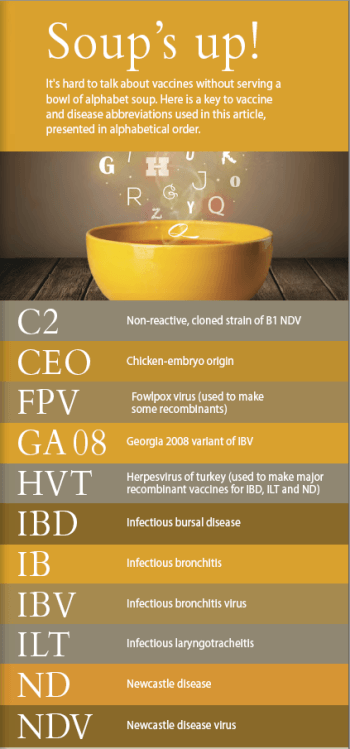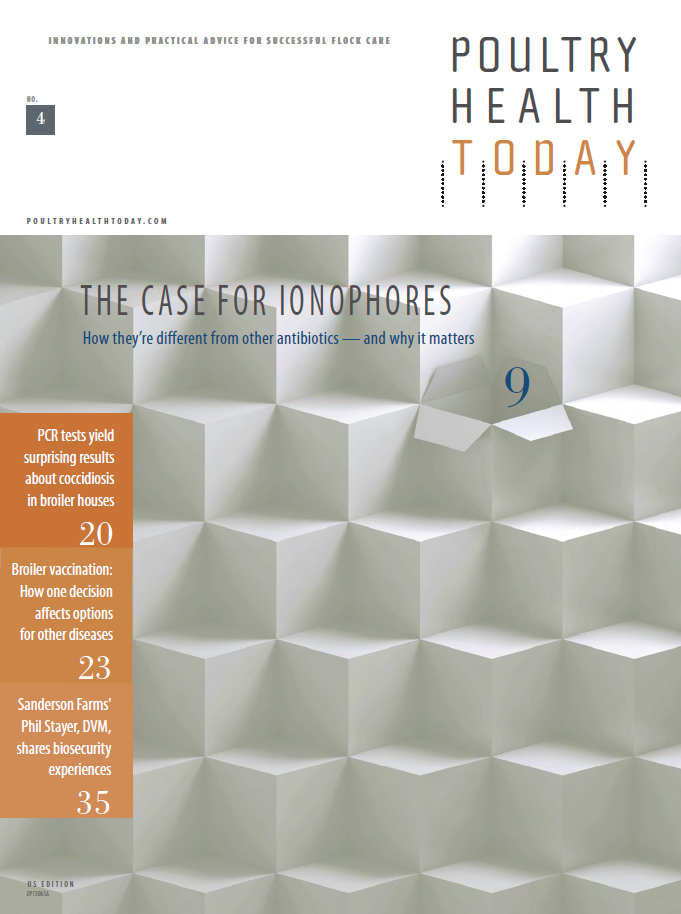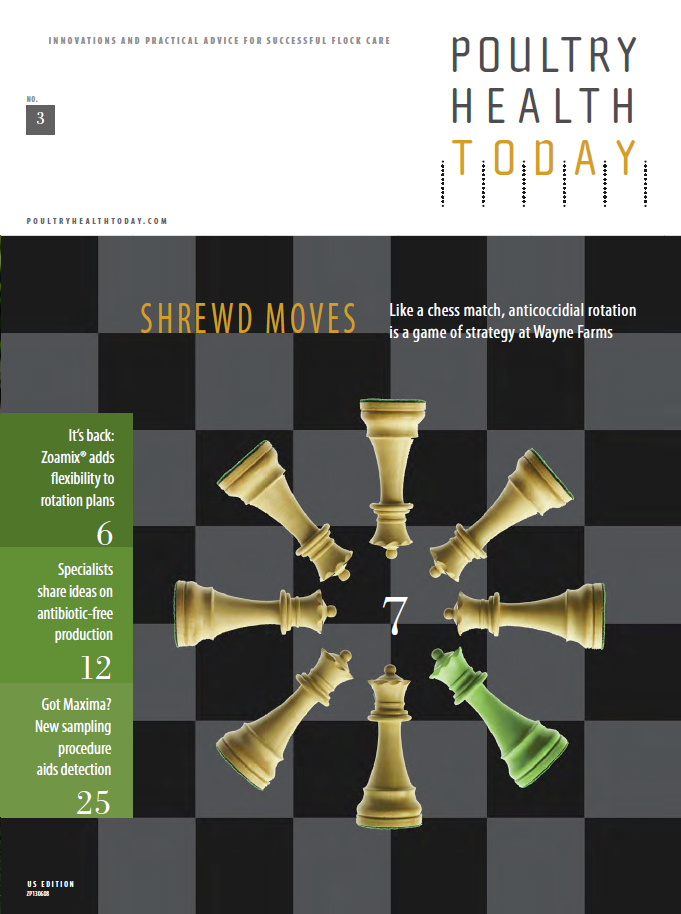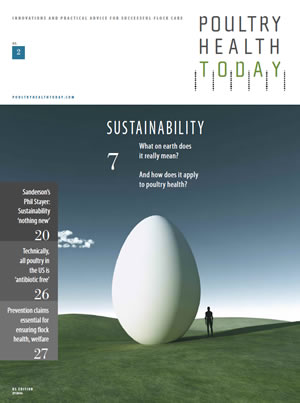

Pathways to protection: How one vaccine decision can affect options for managing other diseases in broilers

Broiler operations naturally want to provide the best disease protection for the least cost, but deciding which vaccines to use and when can be a daunting task.
First, there are so many variables to consider - not just disease pressure and the emergence of new variants, but also geographic location, proximity to other farms, temperature, litter moisture, housing type, ventilation, lighting, bird density, target weight and labor.
Then there’s the overwhelming arsenal of vaccines. Producers have a deep war chest of modified-live, inactivated, autogenous and recombinant vaccines that can be administered in a variety of ways, at different times - often in combination with other immunizations.
Every flock and farm is different and there’s no such thing as a blanket program. So how should broiler farms go about planning cost-effective vaccination programs? And how does one vaccine decision affect a poultry company’s options for managing other diseases?
Poultry Health Today asked two experts with extensive experience evaluating vaccination programs on hundreds of farms - Kalen Cookson, DVM, MAM, and Lloyd Keck, DVM, ACPV - for help in navigating the path to sensible, strategic and cost-effective disease protection.
Square one
What to use for Marek’s disease is usually the first step toward planning a broiler-vaccination program. Even though the incidence of tumors is generally low in US broilers, the Marek’s disease virus is ubiquitous and always a potential cause of immune suppression. “That’s why all broiler operations continue to immunize their flocks against this highly contagious disease,” Cookson says.

While traditional live vaccines for Marek’s are available, many US broiler operations obtain Marek’s protection from a herpesvirus of turkey (HVT) recombinant vector vaccine administered in ovo. HVT helps protect against Marek’s and serves as a vector to help provide protection against one of three other costly diseases — infectious Soups Upbursal disease (IBD), infectious laryngotracheitis (ILT) or Newcastle disease (ND).
Though more expensive than traditional vaccines, the recombinant vector vaccines are popular with broiler producers because they’re easy to administer and offer a high margin of safety, with virtually no reactions that can impede flock performance. The only hitch: Not more than one HVT vaccine, whether a recombinant or not, can be used at the same time because they will compete with each other and become less effective.
That means producers fire only one HVT bullet, so to speak. If they use an HVT-based recombinant to help protect flocks against IBD, that rules out using one for ILT and ND. Likewise, if flocks receive an HVT-based vaccine for ND or ILT, producers will need to resort to other types of vaccines for the other two diseases.
Choosing your weapon
So, if broiler farms get only one shot with an HVT-based recombinant, which disease should they target?
It really comes down to disease pressure, time of year and other vaccination options. Keck recommends using lab testing and physical evidence of disease damage as a starting point. “You want to find the recombinant that’ll deliver the most value in each particular situation,” he says. “Then use traditional vaccines to manage the other major diseases.”
Here’s an overview of four different vaccine scenarios for broilers, with and without recombinants:

When to consider it
Recombinant IBD vaccines are usually the first choice when ILT, ND and infectious bronchitis virus (IBV) pressure is low and growers are faced with a high — or early — IBD challenge.
Winter and spring are peak challenge times for IBD due to lower temperatures and reduced ventilation, which increases the concentration of the virus and field challenge over time.
The recombinant IBD vaccine has been demonstrated to be highly effective on many farms. However, growers must remember that continuous use of a recombinant IBD vaccine only buffers the challenge from the field virus. The viral load and production losses will usually decrease, but the virus continues to replicate, Cookson says. “That allows reinfection in the next cycle of birds and the possible selection of more ‘fit’ subpopulations over time,” he adds.
Managing maternal antibodies plays a key role in any effective IBD-control program. “IBD control begins with the broiler-breeder that shares passive immunity with the broiler,” Cookson says. “You want the vaccine to match the field challenge as closely as possible.”
Options for managing ILT
If an HVT-based recombinant vaccine is being used for IBD, there are two options for managing ILT. One is a fowlpox virus (FPV)-based recombinant for ILT, which can be used without fear of replication competition.
However, the gold standard for ILT control, particularly in large birds, is the modified-live, chicken-embryo origin (CEO) vaccine.
A CEO vaccine can produce a “sterilizing immunity” against the ILT virus and helps break the challenge cycle, Cookson explains. At the same time, however, the CEO vaccine has the potential to spread the disease to unvaccinated birds. Strict biosecurity helps reduce the spread of ILT between vaccinated and unvaccinated barns.
Farms planning to begin a CEO vaccination program should increase biosecurity measures, share plans with neighboring farms and encourage collaboration on vaccination programs.
Options for managing ND
Without a recombinant ND vaccine in the mix, producers must select more traditional ND vaccines, based on disease pressure and history. Available vaccines vary from the nonreactive C2 through the less-attenuated B1 strains.
During winter months, many operations choose to use a C2 vaccine — one that limits reactivity and helps growers avoid putting additional stress on the birds, Cookson says. However, using C2 year-round allows field-virus levels to build — eventually making C2 less effective, particularly against a late NDV challenge.
Cookson recommends “moving up the reactivity/efficacy scale” during summer with a vaccine such as Poulvac® Aero ND. “That approach will help to decrease circulating virus levels and help prevent late-season challenge,” he explains.

When to consider it
Once viewed as a cold-season virus, ILT has become a year-round threat in many broiler-production strongholds of the US. Cold, wet weather and reduced ventilation often trigger ILT outbreaks.
Producers frequently choose to use a recombinant ILT vaccine in situations of low challenge or if the challenge is not present but there is a risk of exposure, particularly in medium-sized birds.
A recombinant vaccine can also be used to jump-start ILT protection and serve as a reaction buffer when a modified-live field vaccine is needed at 14 days.
Keck says that in cases of very high risk or outbreak situations, a recombinant ILT vaccine administered in ovo, followed by a CEO vaccine in the field, may be needed to help reduce mortality levels and ensure ILT immunity. “If a grower is seeing very high mortality rates, the cost of two vaccinations may save money in the long run,” he explains.
When transitioning off a modified-live vaccine program, producers can opt to use a recombinant vaccine in ovo to help buffer against what has hopefully become a diminishing field challenge. It can also be insurance against any residual vaccine persistence.
According to Keck, birds raised to less than 4 pounds (or 5 weeks of age) seldom exhibit mortality from ILT. So, unless growers are facing an outbreak, it may not pay to vaccinate small birds. If an ILT recombinant is needed in a small bird, the FPV recombinant vaccine can be used since it causes fewer reactions and costs less than the HVT vector vaccines.
Bottom line: Each farm needs to look at its history, the surrounding production area and the age and weight of birds when selecting its primary and secondary options for ILT vaccination.
Options for managing IBD
Using a recombinant ILT vaccine presents more options for managing IBD. Among conventional modified-live vaccines, Cookson recommends either using a mild IBD vaccine with Marek’s or an intermediate vaccine that can be administered at 8 to 10 days or with a ND/IBV field boost at 14 to 18 days.
Administering an immune-complex vaccine such as Bursaplex® along with a Marek’s vaccine in ovo is another option. This type of vaccine helps provide strong IBD protection as maternal antibodies decline, he says, thus delaying and reducing the period of infection while allowing for quicker recovery of the bursa of Fabricius — a specialized organ necessary for B cell development in birds.
Another way to help reduce IBD virus levels is to continue vaccinating throughout the summer. Summertime vaccination combined with better ventilation rates reduces IBD pressure going into the following winter.
Options for managing ND
(See ND recommendations under Program A.)

ND peaks in the winter and spring months when cold, wet weather and reduced ventilation rates help the virus replicate. A recombinant, HVT-based ND vaccine helps offer growers “peace of mind” protection, Cookson says, while allowing them to focus live respiratory vaccination on IBV, which also spikes in winter. (See IBV recommendations in the next section.)
While the recombinant ND vaccine is more expensive, it offers little reactivity with moderate disease control. Fortunately, circulating ND viruses in the US are not extremely pathogenic and tend to infect at later ages, allowing recombinant ND vaccines the opportunity to be effective in most situations. Again, the ND vaccine decision must be based on flock history and challenge levels.
Options for managing ND
(See IBD recommendations under Program B.)
Options for managing ND
(See ILT recommendations under Program A.)

When to consider it
Recombinant vaccines are a fairly recent addition to the poultryvaccine arsenal. Cookson estimates that over half of all broiler operations still do not include recombinants in their vaccination programs today.
“It really comes down to perceived need versus cost of the recombinant,” he explains.
Many producers still grow chickens without recombinants, based on their flock history, good disease coverage with their current vaccination plan and to avoid the higher cost associated with recombinants.
Options for managing Marek’s disease
Of course, Marek’s disease can be safely and effectively controlled by using non-recombinant vaccines. The key is to adjust the Marek’s program to help provide adequate protection against tumors and performance losses. For many broiler operations, this has meant developing different vaccination programs for summer and winter.
Options for managing IBD, ILT and ND
(See recommendations for each in Programs A and B.)
More Issues















